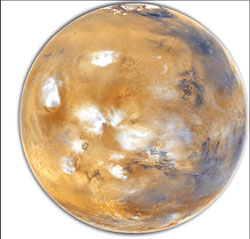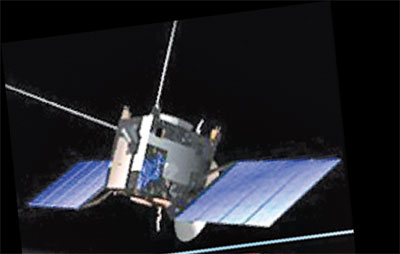|
Variety
Ocean once covered part of Red Planet
Mars Express Radar yields strong evidence:
European Space Agency’s (ESP’s) Mars Express has returned strong
evidence for an ocean once covering part of Mars. Using radar, it has
detected sediments reminiscent of an ocean floor within the boundaries
of previously identified, ancient shorelines on Mars.

The MARSIS radar was deployed in 2005 and has been collecting data
ever since. Jeremie Mouginot, Institut de Planetologie et
d’Astrophysique de Grenoble (IPAG) and the University of California,
Irvine, and colleagues have analysed more than two years of data and
found that the northern plains are covered in low-density material.
“We interpret these as sedimentary deposits, maybe ice-rich,” says Dr
Mouginot. “It is a strong new indication that there was once an ocean
here.”
The existence of oceans on ancient Mars has been suspected before and
features reminiscent of shorelines have been tentatively identified in
images from various spacecraft. But it remains a controversial issue.
Two oceans have been proposed: 4 billion years ago, when warmer
conditions prevailed, and also 3 billion years ago when subsurface ice
melted, possibly as a result of enhanced geothermal activity, creating
outflow channels that drained the water into areas of low elevation.
“MARSIS penetrates deep into the ground, revealing the first 60-80
metres of the planet’s subsurface,” says Wlodek Kofman, leader of the
radar team at IPAG.
“Throughout all of this depth, we see the evidence for sedimentary
material and ice.”
 The
sediments revealed by MARSIS are areas of low radar reflectivity. Such
sediments are typically low-density granular materials that have been
eroded away by water and carried to their final destination. The
sediments revealed by MARSIS are areas of low radar reflectivity. Such
sediments are typically low-density granular materials that have been
eroded away by water and carried to their final destination.
This later ocean would however have been temporary. Within a million
years or less, Dr Mouginot estimates, the water would have either frozen
back in place and been preserved underground again, or turned into
vapour and lifted gradually into the atmosphere.
“I don’t think it could have stayed as an ocean long enough for life
to form.”
In order to find evidence of life, astrobiologists will have to look
even further back in Mars’ history when liquid water existed for much
longer periods.
Nevertheless, this work provides some of the best evidence yet that
there were once large bodies of liquid water on Mars and is further
proof of the role of liquid water in the martian geological history.
“Previous Mars Express results about water on Mars came from the
study of images and mineralogical data, as well as atmospheric
measurements.
Now we have the view from the subsurface radar,” says Olivier Witasse,
ESA’s Mars Express Project Scientist.
What is Mars Express?
The European Space Agency (ESA) and its member countries began
talking about a mission to Mars ever since the Russian Mars ‘96 mission
failed.
That spacecraft carried several European instruments, and the loss to
European planetary science was devastating. Mars Express was conceived
as a low-cost way to refly those experiments and also carry a lander
communications relay which would support missions from 2003 onward. Mars
Express successfully entered orbit of Mars on December 25, 2003.
It has performed excellently since then, and is in the process of
carrying out its primary mission.
In early 2004, the science team for Mars Express confirmed that the
spacecraft had detected evidence of water ice all throughout the
southern polar cap. Mars Express has also returned a stream of
tantalising images of Vallis Marineris, and other planetary features of
Mars.
For surface study, Mars Express carries four instruments. A High
Resolution Stereo Camera (HRSC) will make possible topographic maps of
Mars and can capture images up to a 12 metre resolution.
An IR Mapping Spectrometer (aka OMEGA) conducts rock and soil
analyses in the infrared spectrum.

A Radio Science Experiment (RSE) measures Mars’s interior composition
and geodesy. A Sub-surface Sounding Radar / Altimeter (SSRA) is
measuring the depth and composition of the Martian regolith.
To study the atmosphere, Mars Express carries three instruments. An
Energetic Neutral Atoms Analyser (or ASPERA) studies the upper
atmosphere and examines the effects of the solar wind on it.
A Planetary Fourier Spectrometer (PFS) studies the atmosphere in
infra-red, enabling 3D charts of temperature and pressure to be
produced. A UV Atmospheric Spectrometer (aka SPICAM) measures the
atmospheric composition and structure.
Mars Express will likely produce many more discoveries during its
mission.
[Facts of planet]
* Known since prehistoric times, Mars is still a favorite of choice
for human exploration.
 *Mars
is the fourth planet from the Sun and the seventh largest.It is named
for the Roman g od of War, *Mars
is the fourth planet from the Sun and the seventh largest.It is named
for the Roman g od of War,
*It is sometimes referred to as the Red Planet.
*The density of Mars is about 30 per cent less than that of Earth
(3.94 g/cm3 vs. 5.52 g/cm3). Its core is probably similar to Earth’s,
mostly iron, with small amounts of nickel, but spacecraft mapping of its
gravity field seem to indicate that its iron-rich core and mantle are a
smaller portion of its volume than on Earth.
*Mars’ atmosphere is 95 per cent carbon dioxide, nearly 3 per cent
nitrogen, and * nearly 2per cent argon with trace quantities of oxygen,
carbon monoxide, water vapor, ozone, and other trace gases.

The first spacecraft to visit Mars was Mariner 4 in 1965. Several
others followed including Mars 2, the first spacecraft to land on Mars
and the two Viking landers in 1976. Ending a long 20 year hiatus, Mars
Pathfinder landed successfully on Mars on 1997 July 4. In 2004 the Mars
Expedition Rovers “Spirit” and “Opportunity” landed on Mars sending back
geologic data and many pictures; they are still operating after more
than three years on Mars. In 2008, Phoenix landed in the northern plains
to search for water.
*Three Mars orbiters (Mars Reconnaissance Orbiter, Mars Odyssey, and
Mars Express) are also currently in operation.
Courtesy: The Independent |

